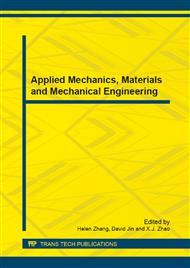[1]
MA Massoud, M EI-Fadel, A Abdel Malak. Assessment of public vs private MSW management : a case study[J]. Environ Manag, 2003, 69(1): 15-24.
DOI: 10.1016/s0301-4797(03)00104-x
Google Scholar
[2]
PJ He, H Zhang, CG Zhang, et al. Characteristics of air pollution control residues of MSW incineration plant in Shanghai[J]. J Hazard Mater, 2004, 116(3): 229-237.
DOI: 10.1016/j.jhazmat.2004.09.009
Google Scholar
[3]
Xiaoqin Ma, Zhongyang Luo, Jianguang Qin, et al. Investigation on the mechanism of agglomeration in biomass combustors at low temperatures[J]. Journal of Solar Energy, 2008, 29(3): 374-378.
Google Scholar
[4]
Elisabet B, Marcus O, Anders N. Mechanisms of Bed Agglomeration During Fluidized-Bed Combustion of Biomass[J]. Energy&Fuels, 2005, 19: 825-832.
DOI: 10.1021/ef0400868
Google Scholar
[5]
Lin W G, Dam-Johansen K, Frandsen F. Agglomeration in bio-fuel fired fluidized bed combustors[J]. Chemical Engineering Journal, 2003. (96): 171-185.
DOI: 10.1016/j.cej.2003.08.008
Google Scholar
[6]
Thy P, Jenkins B M, Lesher C E. High-temperature melting behavior of urban wood fuel ash[J]. Energy&Fuels, 1999. 13(4): 839-850.
DOI: 10.1021/ef980249q
Google Scholar
[7]
Weigang Lin, Kim Dam-Johansen, Flemming Frandsen. Agglomeration in bio-fuel fired fluidized bed combustors[J]. Chemical Engineering Journal, 2003, (96): 171-185.
DOI: 10.1016/j.cej.2003.08.008
Google Scholar
[8]
Christensen K A, Stenholm M, Livbjerg H. The formation of submicron aerosol particles HCl and SO2 in Straw-fired boilers. Journal of Aerosol Science, 1998, 29: 421.
DOI: 10.1016/s0021-8502(98)00013-5
Google Scholar
[9]
SP Bhattacharya, M Harttig. Control of agglomeration and defluidization burning high-alkali, high-sulfur lignites in a small fluidized bed combustors effect of additive size and type and the role of calcium[J]. Energy&Fuels, 2003, 17: 1014-1021.
DOI: 10.1021/ef020205o
Google Scholar
[10]
Rushan Bie, Lidan Yang, Ding Zhou. The influence of additives on the agglomeration in fluidized combustor firing organic liquid waste[J]. Chemical Engineering Journal, 2002, 53(12): 1253-1259.
Google Scholar
[11]
Xiaodong Li. The agglomeration characteristic of organic liquid waste in fluidized combustor[J]. Chemical Engineering Journal, 2005, 56(11): 2170.
Google Scholar


